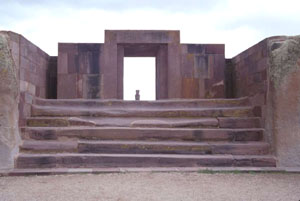|
Archeologists have not yet reached agreement on the age of the Tiahuanaco ruins, the spiritual and political centers of one of the most powerful and ancient cultures of the Andean plateau.
Recently, Carlos Ponce Sanguines, a Bolivian archeologist from the Centro de Investigaciones Antropologicas Tuahuanaco (CEINANTI) (Tiahuanaco Center of Anthropological Research), pointed out that the Tiahuanacan culture developed between 1580 B.C. and 1187 A.D. In turn, old Indian legends place the constructions at the beginning of time and tell that Viracocha, the Sun God, built this ceremonial center in one day.
Its disappearance, in the early 12th Century, is surrounded by mystery, and gave rise to many smaller political entities that in time came together to form the great Inca Empire that the Spaniards found when they arrived in this region. Not only its disappearance, but also other enigmas are still awaiting a scientific answer, such as the placement of the huge monoliths, the presence of a layer of marine sediments, remains of marine fossils, a wharf and dikes suggesting a port at an altitude of almost 4,000 meters.
Long colonnades, huge walls, colossal monoliths, underground aqueducts, bas-reliefs, and all mute witnesses of an extinct civilization. Outstanding features are the ruins of the Akapana pyramid; the temple of Kalasasaya with the Gateway of the Sun, carved from a single block of stone: the "Fraile" an anthropomorphic monolith; and the palaces of Putuni, Laka-Kollu and Kheri-Kala.
The cultivation technique in artificial terraces separated by small irrigation channels, not only allowed them to irrigate and enrich the soil, but it also preserved the heat generated by the sun during the day to tolerate the freezing nights of the plateau. This is how they enhanced the microclimate of the soil, reaching levels that even today many regions of the world are unable to attain. Mankind today owes to the Tiahuancans at least the development of growing potatoes (Solanum Tuberosum), "choque" in the local dialect, basis of the daily diet of most people on the five continents. The ruins of Tiahuanaco in Bolivia, an example of the best of the latin spirit. |
|
|
